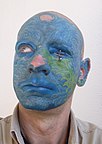1.2. Deviance, Rule Violations, and Criminality
Shanell Sanchez
Nude Ultimate Frisbee
Imagine you recently moved to Oregon for work from Georgia after graduating college and hope to make new friends. Georgia has been your home forever, so Oregon is entirely new. Then one day at the dog park you run into a guy that seems like someone you would like to hang out with and he tells you to come out and play ultimate frisbee this weekend. You decide to take the leap and meet new people, play a new sport, and have some fun.
You arrive on the field, but notice something that stands out as different to you and wonder ‘is this allowed in Oregon?’ Some women and men are naked, some fully and some just have certain parts exposed, but no one seems uncomfortable. You look around at the topless players, all adults, and wonder if this is the wrong place. Other people in costume walk around like Unicorns, Mario, and Rainbow Brite, among others. Suddenly, thoughts start racing through your mind: “Why are people dressed strangely? Is it legal to be nude in public in the state of Oregon? Why does no one seem to mind? Can I keep my clothes on? What will my family in Georgia think? Should I just go back to my apartment now?”
Suddenly, the guy from the dog park runs up and tells you to come on over so he can introduce you to the team. Situations like this are often examples we use in the college classroom to demonstrate the difference between deviance, rule violations, and criminal violations. Sometimes there are times that behaviors that appear to be deviant are not illegal, but other times behaviors that are illegal are not deviant.
Just about everyone in society has done something that someone else would disagree with and see as deviant. For example, I recently wore clothes to the gym that were out of style but how did I know they were out of style? Well, easy! The reaction of others to my lack of style in the gym was clear it is no longer cool to wear knee-high socks with athletic shorts to the gym.
Another time I was at Thanksgiving dinner with my family and I expressed open support for a politician that no one else in the family supported. Their reactions to my support of him made it evident that I was the deviant one who was not going along with the typical political views expected in my reasonably conservative, Republican family.
Alternatively, perhaps I am deviant when I tell you my favorite television show is, and always will be, the Golden Girls, which seems odd for someone in their early thirties. Perhaps someone thinks it is utter nonsense and ‘crazy’ wasting my time watching such shows. These are just a few examples where my behavior, thoughts, actions, or beliefs may be different from those around me.
From a sociological perspective, social norms are all around us and are accepted norms and behaviors that are defined within a specific group. The group you are in can change, which would mean the norms and behaviors that are acceptable at any given time may change.

Deviance is behavior that departs from the social norm. Goode argues that four things must happen for something deviant to take place or exist:
1) a rule or norm must be established; 2) someone has to violate that rule or norm; 3) there must be an audience or someone, that witnesses the act and judges it to be wrong; 4) and there is likely going to be a negative reaction from that audience that can come in many forms (i.e., criticism, disapproval, punishment, and more).
To commit an act of deviance one does not need to violate a dangerous norm, and not all acts that are deviant are criminal. Not all criminal acts are deviant either. Deviance falls on a spectrum that can range from really deviant to not so deviant but remember it is dependent on the audience. Think back to the previous comment about the show Golden Girls. My grandma would not find that as deviant as my husband does because we grew up watching it together. We spent many hours on the couch laughing away at the silliness of it all, so we would both agree it is a beautiful show. [2]
Applying Knowledge
Assignment: Apply Goode’s definition of what needs to happen for something to be considered deviant in no less than 500 words and follow the example below.
Example: The awkward outfit to the gym: knee socks, athletic shorts, and an oversized Broncos t-shirt mentioned above could be deviant. Based on Goode’s definition of deviance, this attire departed from the social norm at the gym in 2018. Whether we realize it or not some specific rules or norms are established in the gym (1); sometimes we have a dress code, but other times, we have to keep up with current ‘hip trends’ such as yoga pants for women in 2018. Next, I violated that norm by my attire (2); since it was a busy Monday night lots of people saw my attire, and my audience, was able to witness my act and then judge it (3). Lastly, they could not kick me out for not dressing cool, but the awkward smirks, stares, and giggles were all I needed to know that my clothes were deviant and not cool (4). This could certainly have not been true in 1950, 1980, or even the early 2000s. If I think back to when I started lifting over a decade ago, yoga pants were unheard of and no one wore anything ‘tight’ to the gym. Today yoga pants are regular and in some parts of the country for women and men.

